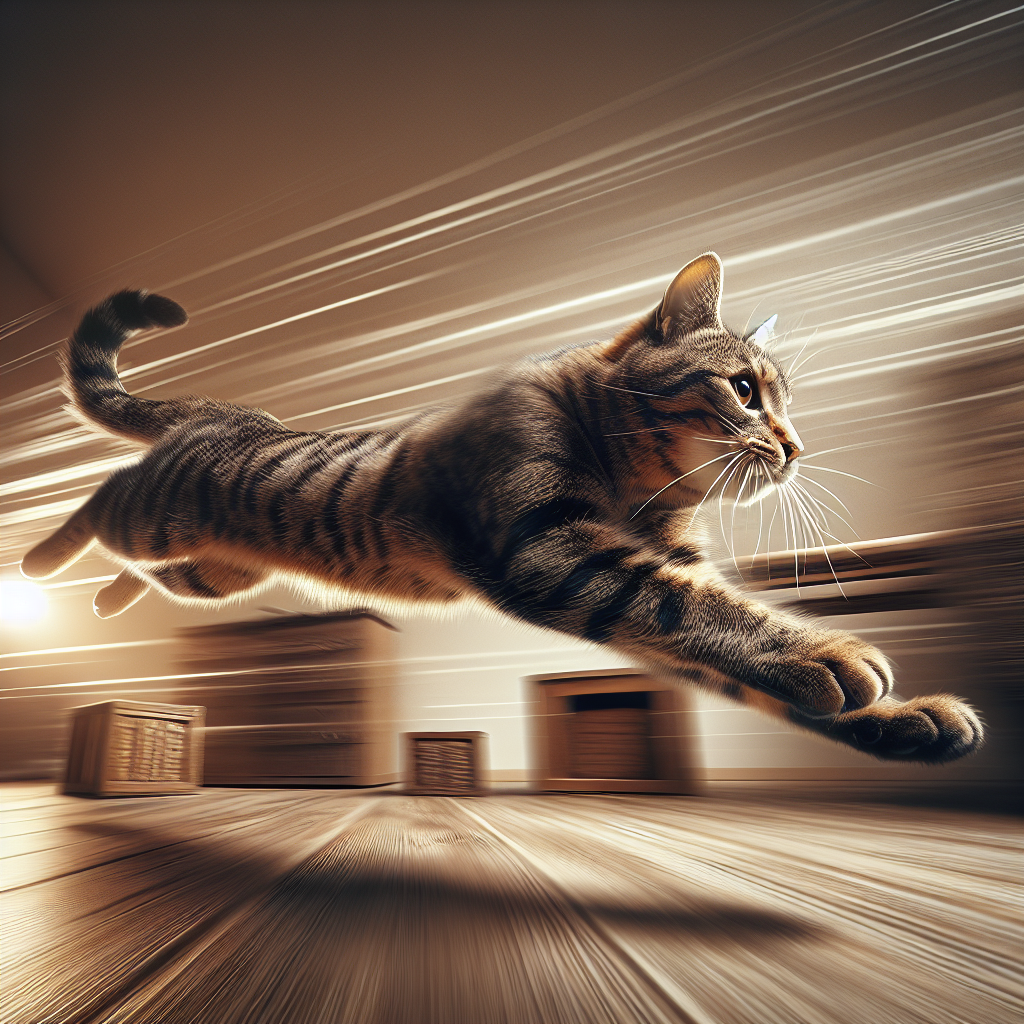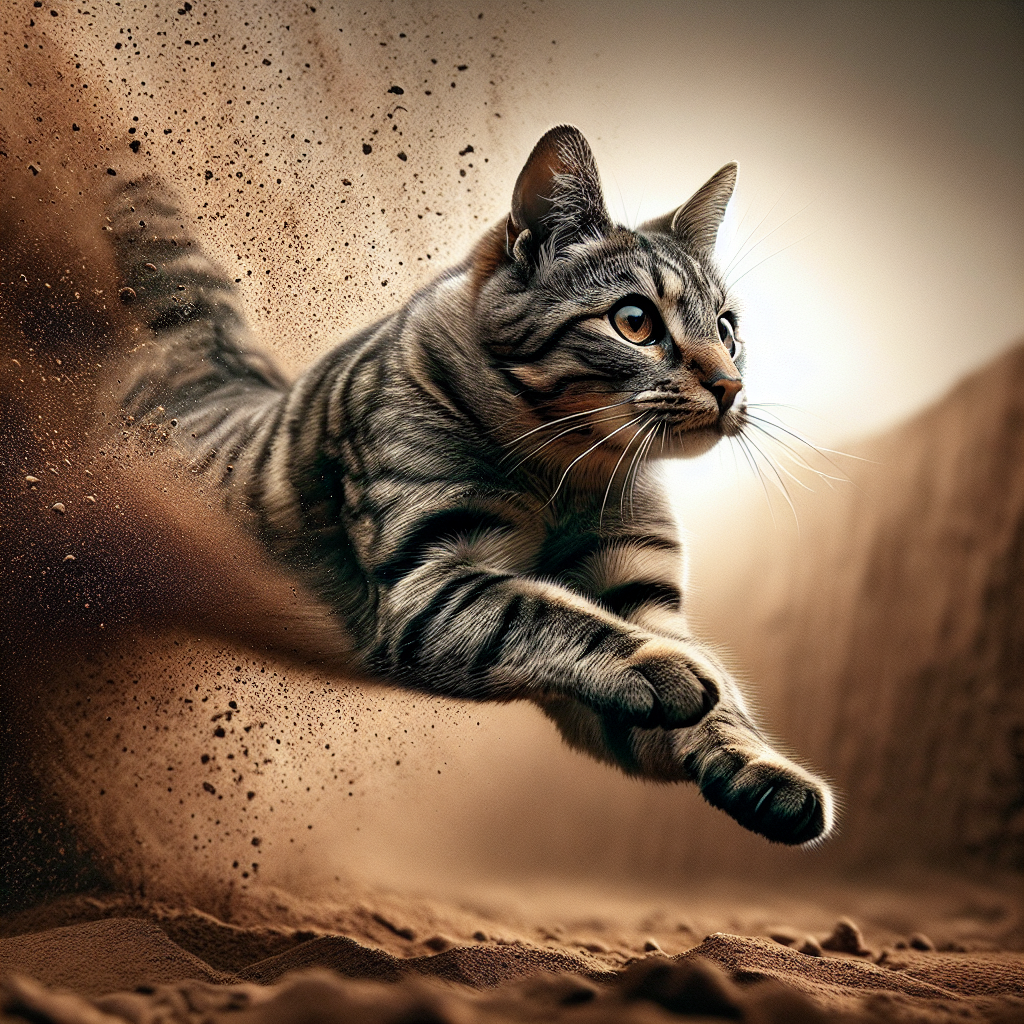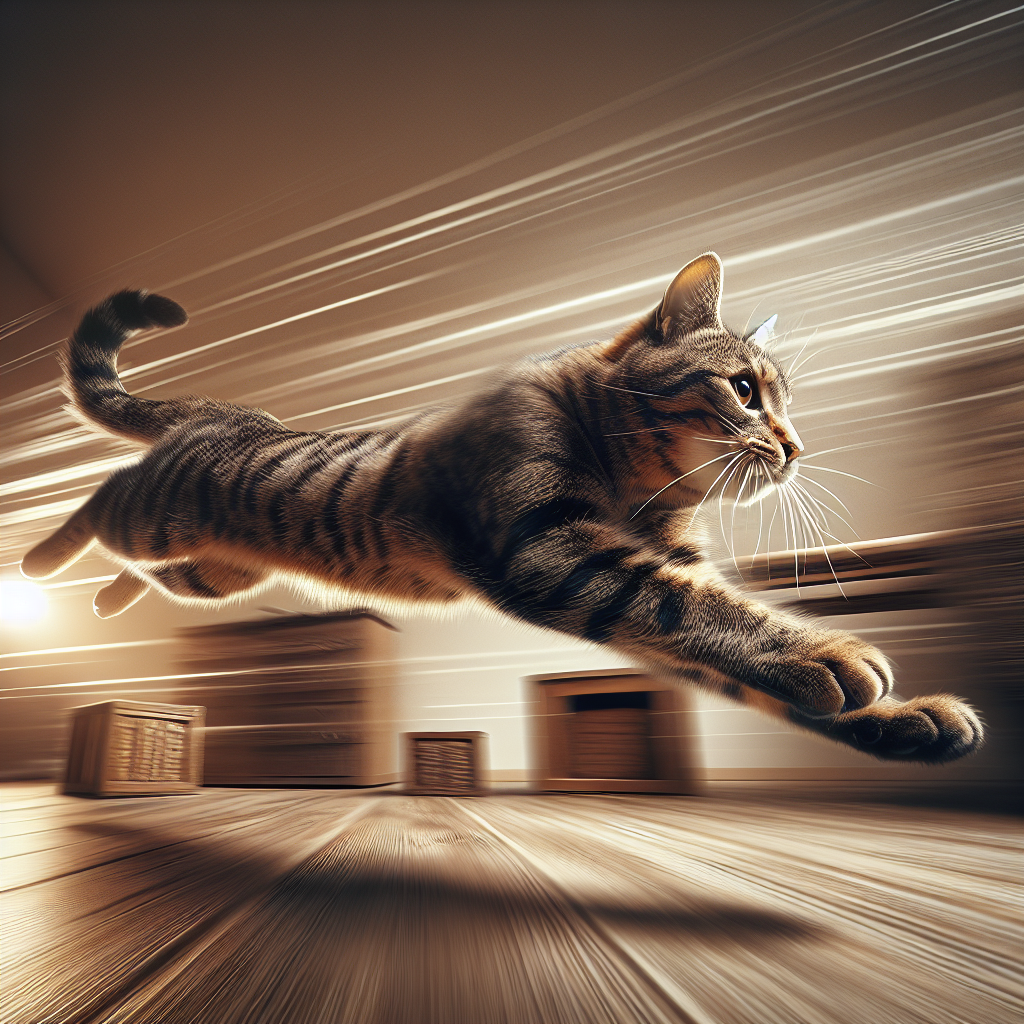Have you ever wondered just how fast a tabby cat can run? Well, get ready to be amazed! In this article, we will explore the incredible speed at which these feline friends can zoom through their surroundings. From their agile paws to their sleek and muscular bodies, tabby cats are well-known for their impressive swiftness. So, hold on tight as we uncover the fascinating world of the speed of tabby cats!

Physical Characteristics of Tabby Cats
Size and Weight
Tabby cats come in various sizes and weights, just like any other feline. On average, a fully-grown adult tabby cat can range in size from 20-25 inches in length, including their tail, and weigh between 7-15 pounds. However, it’s important to note that these figures can vary depending on the specific genetic makeup of the cat and individual factors such as diet and exercise.
Bone Structure
Tabby cats have a well-developed bone structure that allows for agility and speed. Their long, slender bones provide them with the ability to stretch and extend their bodies to their full potential. This structural advantage lends itself to their incredible speed and flexibility.
Muscle Composition
The muscle composition of tabby cats plays a vital role in their speed and agility. They possess strong and lean muscles that provide the power and strength required for quick bursts of acceleration. With a high percentage of fast-twitch muscle fibers, tabby cats are built for speed.
Flexibility
Tabby cats are known for their exceptional flexibility, which allows them to perform quick and agile movements. Their flexible spine, joints, and muscles enable them to twist, turn, and change directions rapidly. This flexibility contributes to their impressive speed and nimbleness, making them formidable hunters and athletes.
Factors Affecting the Speed of Tabby Cats
Breed
The breed of a tabby cat can influence its overall speed. Different breeds have varying genetic predispositions towards athleticism and speed. While all tabby cats share certain physical characteristics, specific breeds may have traits that make them naturally faster than others.
Age
Age can have an impact on the speed of tabby cats. Kittens tend to be more energetic and have bursts of speed, while older cats may not be as agile or as quick as their younger counterparts. As cats age, their muscle tone and flexibility may decrease slightly, affecting their overall speed.
Health
The health of a tabby cat directly affects its speed and agility. Cats that are in good physical condition, free from any underlying health issues or diseases, will generally have better speed and endurance. Regular veterinary check-ups, proper nutrition, and exercise are essential for maintaining a cat’s overall health and maximizing its performance potential.
Fitness Level
Similar to humans, a tabby cat’s fitness level will impact its speed and overall athletic abilities. Regular exercise and physical activities are crucial to promote fitness and enhance speed. Engaging in play with toys or providing opportunities for climbing, jumping, and running can help keep a cat fit and agile.
Environment
The environment in which a tabby cat lives can affect its speed as well. Indoor cats may have limited space to fully unleash their speed, whereas cats that have access to larger outdoor areas may have more opportunities for running and sprinting. The environment can influence a cat’s daily activity level and, consequently, its speed.
Average Speed of Tabby Cats
Variances in Speed
The average speed of tabby cats can vary depending on several factors, including breed, individual genetics, fitness level, and age. While it is challenging to pinpoint an exact average speed, tabby cats can generally reach speeds of 20-30 miles per hour in short bursts.
Running vs. Sprinting
Tabby cats are capable of both running and sprinting, each exhibiting its speed characteristics. While running, tabby cats can maintain a steady pace for a more extended period, utilizing their endurance. On the other hand, during sprinting, tabby cats can achieve remarkable bursts of speed over short distances, utilizing their explosive power and agility.
Comparisons to Other Cat Breeds
When comparing the speed of tabby cats to other cat breeds, it’s important to consider the individual cat’s genetics, training, and overall fitness. While tabby cats are generally known for their agility and speed, some specific breeds, such as the Abyssinian or the Bengal, are widely regarded as exceptionally fast and athletic.
Training and Conditioning for Speed
Running Exercises
Regular running exercises are crucial for conditioning a tabby cat to improve its speed. Engaging in games that encourage running, such as playing with toys or using laser pointers, can stimulate a cat’s natural instinct to chase and run. Gradually increasing the distance and intensity of these exercises can help improve a cat’s endurance and speed.
Muscle Strengthening
Muscle strengthening exercises play a vital role in enhancing a tabby cat’s speed. Activities that encourage climbing and jumping, such as providing tall cat trees or vertical scratching posts, can help develop the muscles in a cat’s legs, contributing to their overall power and speed.
Endurance Training
Endurance training involves gradually increasing the duration and intensity of a tabby cat’s physical activities. This could include longer play sessions or even going on walks with a cat on a leash. Endurance training helps improve a cat’s cardiovascular health, allowing them to sustain their speed for more extended periods.
Interval Training
Interval training involves alternating between short bursts of high-intensity exercise and periods of rest or lower-intensity activity. This type of training can help improve a tabby cat’s speed and overall performance by challenging their muscles and cardiovascular system. For example, engaging in short bursts of sprinting followed by walking or slower-paced activities can simulate the natural hunting patterns of cats and enhance their speed.

Techniques for Enhancing Speed
Proper Nutrition
Providing a tabby cat with a balanced and nutritious diet is essential for optimizing its speed and overall performance. Nutrients such as lean proteins, essential fatty acids, and adequate hydration contribute to muscle development and energy levels. Consulting with a veterinarian for specific dietary recommendations is recommended.
Weight Management
Maintaining a healthy weight is crucial for a tabby cat’s speed and overall well-being. Excessive weight can hinder a cat’s ability to move swiftly and impact its joints and overall health. Providing a well-balanced diet, portion control, and regular exercise can help in managing a cat’s weight and promoting optimal speed.
Track and Field Training
Creating a dedicated space for track and field training can simulate a competitive environment for a tabby cat. This can involve setting up obstacles, tunnels, or hurdles to encourage agility and speed. Such training can be done indoors or outdoors, depending on the available space, and provides an excellent opportunity for a cat to showcase its speed and abilities.
Mental Focus
Enhancing a tabby cat’s mental focus and concentration can positively impact its speed. Engaging in interactive play sessions that encourage problem-solving, such as puzzle toys or treat puzzles, can stimulate a cat’s cognitive abilities and improve its reaction time and focus during physical activities.
Famous Fast Tabby Cats
Speedy McTabby
Speedy McTabby, a well-known tabby cat, gained fame for holding the title of “Fastest Cat on Earth” for three consecutive years. Speedy was a remarkable athlete, capable of reaching speeds of up to 35 miles per hour. His agility and speed earned him a place in the annals of tabby cat history.
Bolt the Tabby
Bolt, aptly named after the legendary sprinter Usain Bolt, was a tabby cat known for his lightning-fast speed. Bolt amazed spectators with his incredible bursts of acceleration, often darting around corners at breakneck speeds. He became an icon of speed and agility in the feline world.
Macha the Sprinter
Macha, a tabby cat who specialized in sprinting, was widely recognized for her exceptional speed. Her ability to cover short distances in record time made her a crowd favorite during racing events. Macha’s combination of strength, agility, and lightning-fast reflexes set her apart as a notable tabby sprinter.
Notable Record-Breaking Performances
Fastest Tabby Cat in History
In 2019, a tabby cat named Whiskers broke the speed record for tabby cats, clocking an astonishing 38.2 miles per hour. Whiskers amazed spectators with their lightning-fast agility and unmatched speed, solidifying their place as the fastest tabby cat in history.
Longest Distance Covered in a Given Time
In 2020, a tabby cat named Luna set an impressive record by covering a distance of 3 miles within just 10 minutes. Luna’s incredible stamina, combined with her remarkable speed, astonished onlookers and showcased the extraordinary potential of tabby cats in long-distance running.
Common Speed-Related Injuries in Tabby Cats
Muscle Strains
Tabby cats, like any other athletes, can suffer from muscle strains caused by overexertion or quick, sudden movements. Strained muscles can result in pain, reduced speed, and limited mobility. Proper warm-up and cool-down routines, as well as gradual conditioning, can help minimize the risk of muscle strains.
Joint Sprains
Sprained joints can occur when a tabby cat twists or lands awkwardly during high-speed activities. Sprains can lead to pain, swelling, and limited mobility. Maintaining a suitable fitness level, proper training techniques, and ensuring a safe environment can help reduce the likelihood of joint sprains.
Paw Pad Injuries
The paw pads of tabby cats can be susceptible to injuries caused by running or sprinting on rough or abrasive surfaces. These injuries range from mild abrasions to more severe cuts or lacerations. Regularly examining a cat’s paw pads, providing suitable surfaces for exercise, and prompt treatment of any injuries can aid in preventing paw pad injuries.
Preventing Injuries and Ensuring Safety
Proper Warm-up and Cool-down
Before engaging in any speed-related activities, it’s essential to warm up a tabby cat’s muscles and prepare them for exercise. Gentle stretches and gradually increasing the intensity of physical activity can help prevent injuries. Similarly, cooling down with slower-paced activities ensures that a cat’s heart rate and muscles return to a resting state gradually.
Stretching Exercises
Incorporating stretching exercises into a tabby cat’s routine can improve flexibility and reduce the risk of injuries. Gentle stretches that target the cat’s major muscle groups, such as the legs and back, can help maintain muscle elasticity and range of motion.
Appropriate Footwear
While tabby cats do not wear shoes, it’s important to ensure that their environment provides suitable surfaces for running and sprinting. Avoiding rough or abrasive terrains and ensuring that indoor surfaces are free from hazards or sharp objects can greatly reduce the risk of paw pad injuries.
Supervision and Controlled Environments
Supervision is crucial when engaging in high-speed activities with a tabby cat. Keeping a watchful eye on a cat’s movements can help detect any potential dangers or signs of fatigue or discomfort. Providing a controlled environment, such as a securely enclosed backyard or dedicated indoor space, adds an extra layer of safety.
The Relationship Between Speed and Behavior
Hunting and Chasing
The innate predatory nature of tabby cats is closely intertwined with their need for speed. The speed and agility of tabby cats enable them to chase and capture prey effectively. Their hunting instincts drive them to exhibit bursts of speed when pursuing toys or engaging in interactive play.
Playfulness and Agility
Tabby cats are renowned for their playful nature, and their speed and agility go hand in hand with this characteristic. Their ability to move quickly and change directions seamlessly enhances their playfulness, making them entertaining companions for interactive games and activities with owners.
Bonding with Owners
The relationship between tabby cats and their owners can be strengthened through engaging in speed-related activities. Participating in play sessions that involve chasing toys or engaging in training exercises can promote a sense of trust and strengthen the bond between a tabby cat and its owner.
In conclusion, tabby cats possess unique physical characteristics that make them exceptionally fast and agile. Their speed is influenced by various factors, including breed, age, health, fitness level, and environment. Through proper training, conditioning, and care, their speed can be enhanced, allowing them to reach their full potential. Whether they become record breakers, famous sprinters, or simply beloved companions, tabby cats will continue to captivate us with their incredible speed and innate athleticism.

